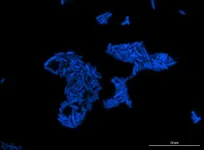(Press-News.org) Modern-day agriculture faces two major dilemmas: how to produce enough food to feed the growing human population and how to minimize environmental damage associated with intensive agriculture. Keeping more nitrogen in soil as ammonium may be one key way to address both challenges, according to a new paper in the Proceedings of the National Academy of Sciences (PNAS).
Today's use of nitrogen fertilizers contributes heavily to greenhouse gas emissions, air pollution, and water pollution, but they are also essential for growing crops. Reducing this pollution is critical, but nitrogen use is likely to grow with increased food production. At the same time, the world's human population is increasing, and agriculture needs to efficiently produce enough food to feed everyone without resorting to clearing more forests for agriculture.
In the past, farmers have managed to increase food production by adding more nitrogen fertilizers to their farm lands, but doing so is no longer a viable or acceptable solution. Instead, farmers should consider shifting to a blend of nitrate and ammonium, the researchers argue, which can decrease pollution and increase food production. Ammonium, a form of nitrogen, binds to soil and so is less likely to leach into waterways.
"Present fertilizer systems are polluting, inefficient, and damaging to ecosystem health," said paper co-author Guntur Subbarao, a senior researcher at the Japan International Research Center for Agricultural Sciences (JIRCAS). "If farming can shift from relying entirely on nitrate in soils to a system with a blend of nitrate and ammonium, it could have far-reaching consequences in limiting nitrogen pollution while boosting crop yields."
"New tools for maintaining more existing soil nitrogen in the form of ammonium could also enable selection of crop varieties that achieve higher yields through a blend of nitrogen forms," said co-author Tim Searchinger, a senior research scholar at the Center for Policy Research on Energy and the Environment, which is based at Princeton University's School of Public and International Affairs. "The prospect exists for a double-benefit that reduces nitrogen pollution, including greenhouse gas emissions, and helps the world to save forests by producing substantially more food on the same land."
Most strategies for mitigating nitrogen pollution rely on limiting pollution at the "front end" - by attempting to more carefully apply fertilizer. However, the authors explain that no matter how carefully fertilizer is applied, there is always a leakage of nitrogen at the "back end." This leakage occurs because soil nitrogen in croplands quickly turns into nitrate, a form of nitrogen that easily leaches into groundwater and waterways and whose breakdown releases nitrous oxide, a powerful greenhouse gas.
This is where ammonium comes in, the authors say. It does not degrade into nitrous oxide unless turned into nitrate first. The article shows that while high levels of ammonium are toxic to most plants, a little appreciated line of research has shown that a mixture of nitrate and ammonium tends to increase crop yields substantially, even by 50% or more, compared to the common soil conditions today that are nearly all nitrate.
This academic finding was irrelevant until recently because microorganisms in crop fields rapidly turn nitrogen into nitrate in a process known as nitrification. However, the authors identify two emerging ways of keeping a greater balance of nitrogen forms in soils. One is to use synthetic nitrification inhibitors with coatings to limit nitrification for extended periods. The other is to take advantage of the natural ability of some plants to prevent nitrification. A plant trait that prevents microbes from converting ammonium to nitrate was first discovered in a commonly planted tropical grass, but researchers have recently begun breeding varieties of all the major grains, like wheat, to have this property.
By cultivating plants that benefit from ammonium and that aid ammonium retention in the soil by inhibiting nitrification, farmers, scientists, and policymakers could effectively increase food production while minimizing environmental degradation. The authors recommend additional research efforts, as there is currently no large-scale funding support for these efforts. They also recommend policies that shift fertilizer subsidies toward fertilizer forms or crop varieties that inhibit nitrification.
"One key benefit of this research is that once these varieties are created, all farmers around the world should be able to use them without additional cost and with the benefit of higher yields," Subbarao said.
INFORMATION:
The paper, "A 'more ammonium solution' to mitigate nitrogen pollution and boost crop yields," was published in PNAS on May 26, 2021. This work was supported by JIRCAS, CRP-WHEAT, and the Walton Family Foundation.
UNIVERSITY PARK, Pa. -- One of the most important and widespread reef-building corals, known as cauliflower coral, exhibits strong partnerships with certain species of symbiotic algae, and these relationships have persisted through periods of intense climate fluctuations over the last 1.5 million years, according to a new study led by researchers at Penn State. The findings suggest that these corals and their symbiotic algae may have the capacity to adjust to modern-day increases in ocean warming, at least over the coming decades.
Cauliflower corals -- which are in the genus Pocillopora -- are branching corals that provide critical habitat for one-quarter of the world's fish and many kinds of invertebrates, such as lobsters, sea urchins and giant clams. ...
To help patients manage their mental wellness between appointments, researchers at Texas A&M University have developed a smart device-based electronic platform that can continuously monitor the state of hyperarousal, one of the signs of psychiatric distress. They said this advanced technology could read facial cues, analyze voice patterns and integrate readings from built-in vital signs sensors on smartwatches to determine if a patient is under stress.
Furthermore, the researchers noted that the technology could provide feedback and alert care teams if there is an abrupt deterioration in the patient's mental health.
"Mental health can change very rapidly, and a lot of these changes remain hidden from providers or counselors," said Dr. Farzan Sasangohar, assistant ...
Like a good story, feeding has a beginning, a middle and an end. It begins with appetite prompting the search for food, continues with eating the food and it ends when satiation hits and the consumption of food is stopped.
At Baylor College of Medicine, Dr. Qi Wu, Dr. Yong Han and their colleagues have uncovered new aspects of the last part of this story that relate to the little-known neural circuits and neurotransmitters involved in ending food consumption.
The team discovered a novel circuit that connects a unique subset of dopamine-producing neurons with downstream neurons in the hindbrain (lower brainstem) ...
The province of Quebec is one of only a few jurisdictions to enshrine sustainable development into law. In 2006 the then-Liberal government of Jean Charest adopted the END ...
Up to half of patients with head and neck squamous cell carcinoma will experience tumor recurrence or new tumors--tumors that often spread and are difficult to treat.
A team of scientists led by the University of Michigan School of Dentistry identified a mechanism by which head and neck cancer cells subvert adjacent normal tissue, allowing small clusters of cancer cells to burrow beneath the healthy tissue.
The team decided to look at this particular mechanism in head and neck cancer because a specific gene, DMBT1, appeared on a screen of genes that are silenced during oral cancer, said principal investigator Nisha D'Silva, the Donald A. Kerr Endowed ...
ITHACA, N.Y. - Approximately one-third of all U.S. counties do not exempt grocery foods from the general sales tax, which means the lowest-income families living in those areas are most susceptible to food insecurity. New research from Cornell University finds that even a slight grocery tax-rate increase could be problematic for many.
"An increase of 1% to 4% may sound small, but after several trips to the grocery store, the extra costs can create serious burdens for the lowest-income families," said co-author Harry Kaiser, professor of applied economics and management in the Charles H. Dyson School of Applied ...
The carefully orchestrated dance between the immune system and the viral proteins that induce immunity against COVID-19 may be more complex than previously thought. A new study by investigators at Brigham and Women's Hospital used an ultrasensitive, single-molecule array (Simoa) assay to detect extremely low levels of molecules in the blood and measured how these levels change over the days and weeks following vaccination. The team found evidence of circulating protein subunits of SARS-CoV-2, followed by evidence of the body mounting its immune response and then clearing the viral protein to below the level of single-molecule detection. Results are published in Clinical Infectious Diseases.
"Because of ...
Bacteria called methylotrophs can use methane and methanol as fuel; in doing so, they produce large amounts of formaldehyde during growth, but until recently no one knew how they detected and responded to this toxic compound. Publishing on 26th May, 2021 in the Open Access journal PLOS Biology, Christopher Marx of the University of Idaho and colleagues describe their discovery of a novel formaldehyde sensor in the bacterium Methylorubrum extorquens, and other methylotrophs.
Some may remember the pungent smell of this toxic chemical from high school dissections of formaldehyde-preserved animals. From bacteria to humans, all organisms produce at least a little formaldehyde ...
May 26, 2021, CLEVELAND: According to new findings published in Science Translational Medicine, Cleveland Clinic researchers have identified a promising drug target for treating and preventing aggressive, drug-resistant prostate cancer.
The team, led by Nima Sharifi, M.D., of Cleveland Clinic's Lerner Research Institute, demonstrated that inhibiting the protein H6PD led to significantly reduced tumor sizes and improved survival among mouse models with drug-resistant prostate cancer. The H6PD levels also were elevated in biopsied patient tumors, suggesting the protein might be targeted ...
Milwaukee, May 26, 2021 - A non-opioid based target has been found to alleviate chronic touch pain and spontaneous pain in mice. Researchers at the Medical College of Wisconsin (MCW) discovered that blocking transient receptor potential canonical 5 (TRPC5) activity reversed touch pain in mouse models of sickle cell disease, migraine, chemotherapy-related pain, and surgical pain.
TRPC5 is a protein that is expressed in both mouse and human neurons that send pain signals to the spinal cord. The findings were published in Science Translational Medicine. The senior and co-first authors of the manuscript, respectively, are MCW researchers ...


